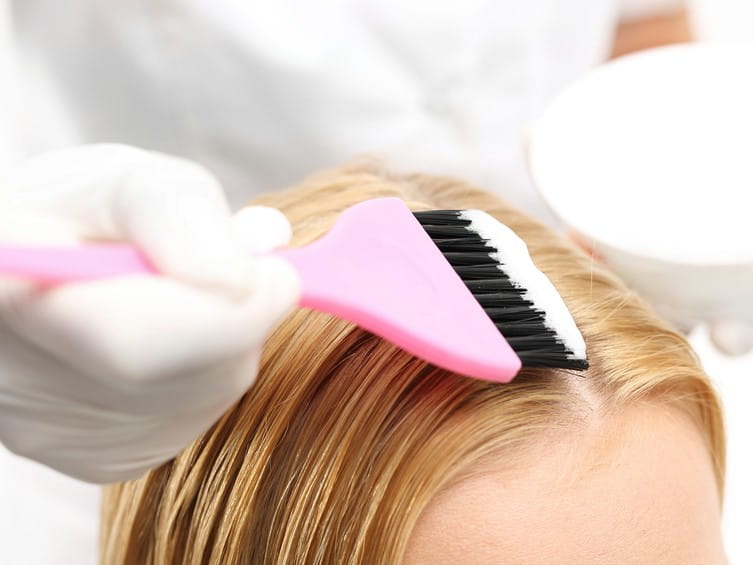Concerns about hair dye: Prevent injuries and allergic reactions

The Bottom Line
Even when hair dyes are used correctly, they can cause toxicity. Skin damage and allergic reactions are well documented. Eye exposure can cause mild irritation to loss of vision. Unintentionally swallowed hair dye can cause irritation or injury to the mouth and stomach as well as life-threatening allergic reactions.

Structure of hair
Hair has two major parts - the hair follicle and the hair shaft. The hair follicle is located at the root of the hair and attaches each hair to the scalp. The hair shaft sticks out of the follicle. Hair follicles contain living cells, but hair shafts do not. Hair color comes from the pigment melanin, which is made by cells in the hair follicle. Hair turns gray when the production of melanin decreases or stops.
How do hair dyes work?
Hair dyes remove the natural color or add new color to the hair shaft. They can be natural or synthetic. Natural dyes like henna are obtained from plants. Synthetic hair dyes can be divided into 3 general categories: temporary, semi-permanent, and permanent. Temporary dyes only penetrate the outermost layer of the hair shaft and are easily removed with a single shampooing. Semi-permanent and permanent dyes reach deeper into the hair shaft. While semi-permanent dyes are removed with 4–12 shampoos, permanent dyes are resistant to shampooing. Permanent dyes cause chemical changes that increase the penetration of the product into the hair, bleach the natural melanin, and create color molecules that get trapped inside the shaft. These chemical changes can damage hair. Semi-permanent dyes also contain chemicals that can remove melanin from the hair shaft, but they are not as strong and cause less damage.
Permanent hair dyes are those most frequently associated with health risks. These products typically include an alkalizing agent like ammonia, an oxidizing agent like hydrogen peroxide, a primary intermediate such as paraphenylenediamine (PPD), and coupler molecules like resorcinol. The alkalizing agent helps the product penetrate the outer layer of the hair shaft, and the other ingredients cause the chemical reactions that create color molecules inside the hair shaft.
Are hair dyes toxic if swallowed?
Unintentional ingestions of dyes by children usually involve small amounts. Temporary hair dyes, like the kind used at Halloween, should only cause minor irritation to the mouth, some nausea, and maybe some vomiting. Toxicity is increased with semi-permanent and permanent dyes because of their alkalizing and oxidizing agents. More severe irritation of the mouth, throat, and stomach would be expected, and more severe vomiting is also likely. Depending on the product, a chemical burn is possible. Even small amounts of products with primary intermediates like PPD can cause life-threatening allergic reactions including swelling of the tongue and throat and difficulty breathing.
Can hair dyes damage skin?
Even when hair dyes are used as directed, harmful health effects are possible. Up to 25 different ingredients in hair dyes can cause harmful skin effects. One of the main culprits is the primary intermediate PPD. Contact with skin can cause irritation, including redness, sores, itching, and burning. Occasionally, allergic reactions occur and involve swelling of the face and neck that causes difficulty breathing. These toxic effects can occur immediately or up to a day after contact with the skin.
Gloves should be worn to limit the skin toxicity of hair dye. One study found that nitrile gloves clearly outperformed natural rubber, latex, polyethylene, and vinyl gloves. Disposable gloves should never be reused. Wearing gloves does not protect the scalp, neck, forehead, ears, and eyelids.
Can hair dyes damage the eyes?
If a temporary dye product gets into the eyes, it would be expected to cause minor irritation. Greater injury is possible with semi-permanent and permanent dyes. The FDA reports eye injuries, including blindness, have been caused by permanent hair dye. These products should never be used to color eyebrows or eyelashes.
Do hair dyes cause cancer?
Some of the ingredients in hair dyes have been suspected of causing cancer, but there are currently no well-done, human studies that show a definite, increased cancer risk.
What to do if someone is unintentionally exposed to hair dye.
If you suspect someone has swallowed hair dye, immediately check the webPOISONCONTROL® online tool for guidance or call Poison Control at 1-800-222-1222. If the hair dye is in the eye or on the skin, rinse first with room temperature water for 15 minutes then check the webPOISONCONTROL online tool for guidance, or call Poison Control at 1-800-222-1222.
Karen Dominguez, PharmD
Certified Specialist in Poison Information
Revised William G. Troutman, PharmD
Professor of Pharmacy Emeritus
Poisoned?
Call 1-800-222-1222 or
Prevention Tips
- Keep hair dyes out of the reach of children.
- Follow all directions on the label and packaging.
- Wear gloves when dying hair. Do not reuse gloves.
- Keep hair dye products away from your eyes.
- Do not use hair dye to color eyelashes or eyebrows.
This Really Happened
A father called Poison Control when his 15-month-old daughter got professional-strength hair dye in her eyes and in and around her mouth. Poison Control researched the product and identified the ingredients. One of the ingredients had the potential to cause changes in vision and allergic reactions. Poison Control gave the father specific instructions on how to irrigate her eyes, wash her skin, and dilute the dye that got into her mouth.
Poison Control called back a few hours later and again the next day to make sure no serious effects occurred. The child developed some minor redness in her eyes and irritation of her tongue. These symptoms later resolved.
For More Information
Hair dyes. US Food and Drug Administration Reviewed October 10, 2024. Accessed August 27, 2025.
References
Poisoned?
Call 1-800-222-1222 or
Prevention Tips
- Keep hair dyes out of the reach of children.
- Follow all directions on the label and packaging.
- Wear gloves when dying hair. Do not reuse gloves.
- Keep hair dye products away from your eyes.
- Do not use hair dye to color eyelashes or eyebrows.
This Really Happened
A father called Poison Control when his 15-month-old daughter got professional-strength hair dye in her eyes and in and around her mouth. Poison Control researched the product and identified the ingredients. One of the ingredients had the potential to cause changes in vision and allergic reactions. Poison Control gave the father specific instructions on how to irrigate her eyes, wash her skin, and dilute the dye that got into her mouth.
Poison Control called back a few hours later and again the next day to make sure no serious effects occurred. The child developed some minor redness in her eyes and irritation of her tongue. These symptoms later resolved.
